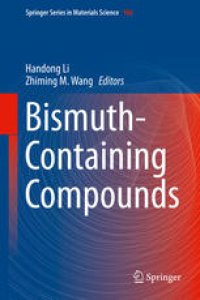
Ebook: Bismuth-Containing Compounds
- Tags: Optical and Electronic Materials, Optics Optoelectronics Plasmonics and Optical Devices, Nanotechnology and Microengineering, Nanochemistry, Semiconductors, Laser Technology Photonics
- Series: Springer Series in Materials Science 186
- Year: 2013
- Publisher: Springer-Verlag New York
- Edition: 1
- Language: English
- pdf
Bismuth-containing compounds comprise a relatively unexplored materials system that is expected to offer many unique and desirable optoelectronic, thermoelectric, and electronic properties for innovative device applications. This book serves as a platform for knowledge sharing and dissemination of the latest advances in novel areas of bismuth-containing compounds for materials and devices, and provides a comprehensive introduction to those new to this growing field. Coverage of bismides includes theoretical considerations, epitaxial growth, characterization, and materials properties (optical, electrical, and structural). In addition to the well-studied area of highly mismatched Bi-alloys, the book covers emerging topics such as topological insulators and ferroelectric materials. Built upon fundamental science, the book is intended to stimulate interest in developing new classes of semiconductor and thermoelectric materials that exploit the properties of Bismuth. Application areas for bismide materials include laser diodes for optical communications, DVD systems, light-emitting diodes, solar cells, transistors, quantum well lasers, and spintronic devices.
Bismuth-containing compounds comprise a relatively unexplored materials system that is expected to offer many unique and desirable optoelectronic, thermoelectric, and electronic properties for innovative device applications. This book serves as a platform for knowledge sharing and dissemination of the latest advances in novel areas of bismuth-containing compounds for materials and devices, and provides a comprehensive introduction to those new to this growing field. Coverage of bismides includes theoretical considerations, epitaxial growth, characterization, and materials properties (optical, electrical, and structural). In addition to the well-studied area of highly mismatched Bi-alloys, the book covers emerging topics such as topological insulators and ferroelectric materials. Built upon fundamental science, the book is intended to stimulate interest in developing new classes of semiconductor and thermoelectric materials that exploit the properties of Bismuth. Application areas for bismide materials include laser diodes for optical communications, DVD systems, light-emitting diodes, solar cells, transistors, quantum well lasers, and spintronic devices.
- Features comprehensive coverage of novel bismuth-related materials and devices
- Covers an emerging materials system with high potential for device applications
- Written by leading experts in the corresponding research areas
- Provides a foundation for the development of future optoelectronic, thermoelectric, and electronic devices